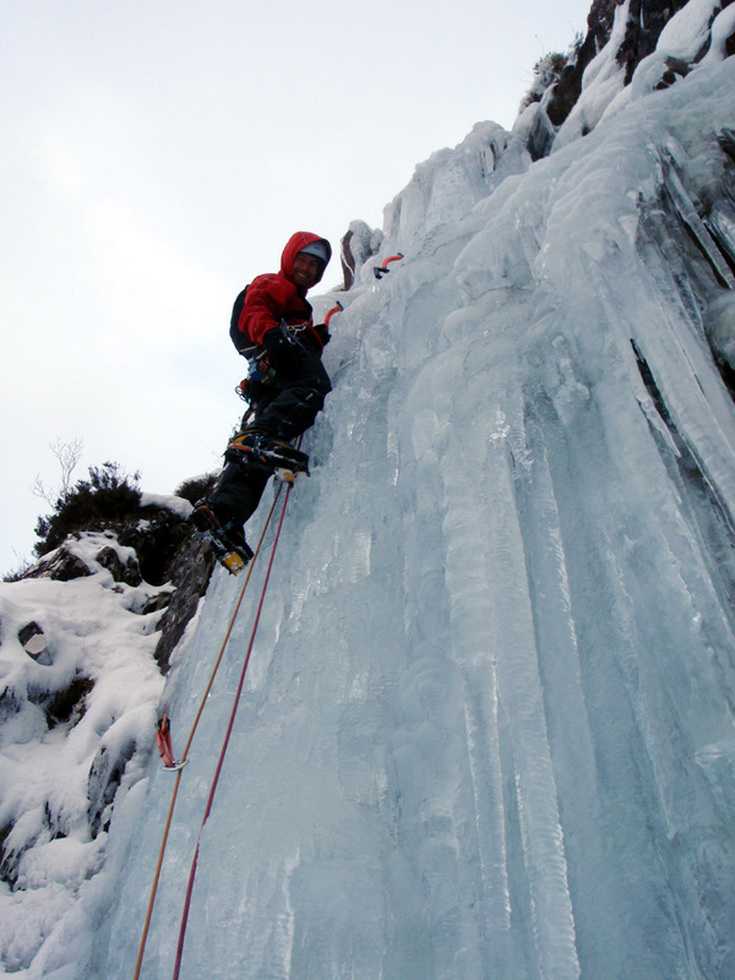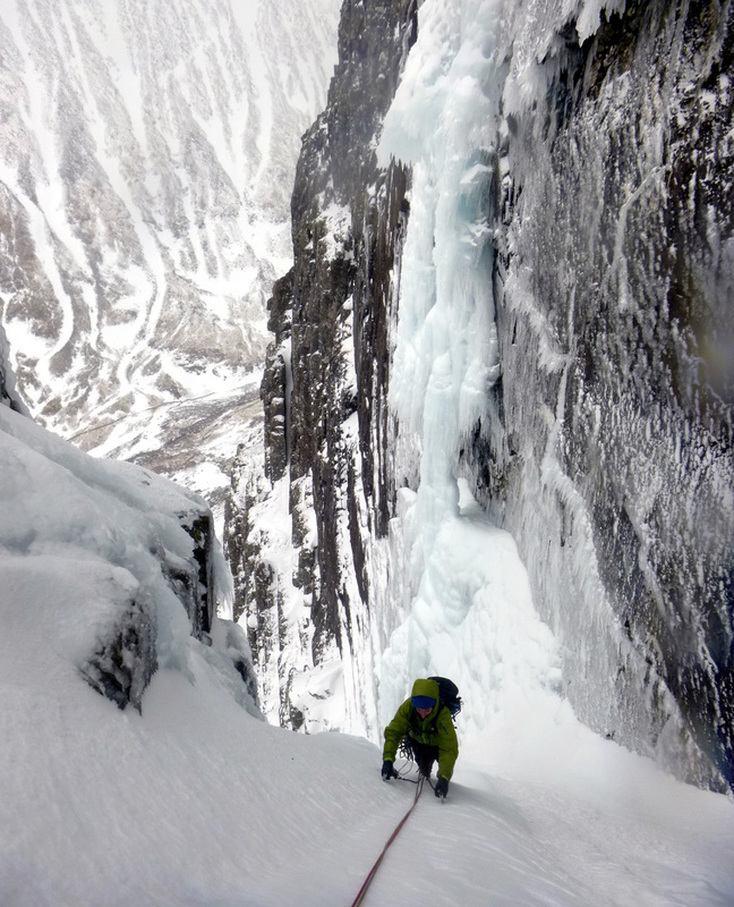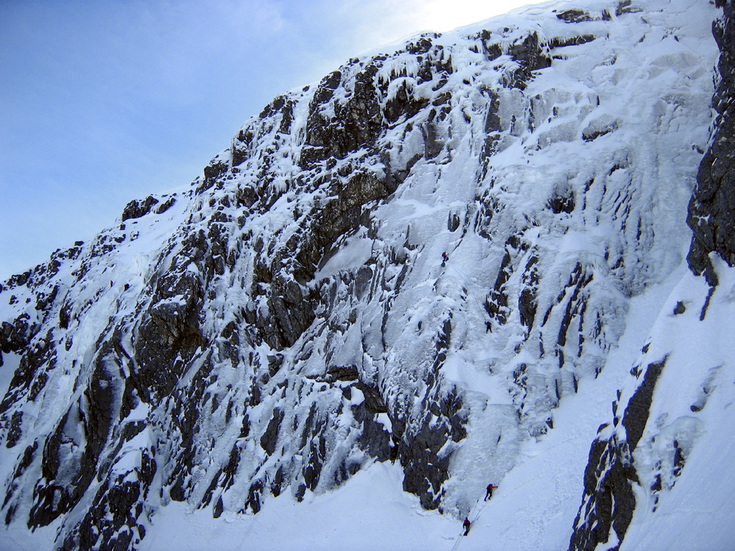|
Modern ice climbing was invented in Lochaber! Pioneers of front pointing and technical ice-picks developed their techniques and tools on the ice of Ben Nevis and Glen Coe. Cutting edge climbers including John Cunningham, Hamish MacInnes, Bill March and Kenny Spence came together to meet Yvon Chouinard in the Clachaig in February 1970, a meeting that resulted in the step cutting era ending overnight for all those there. Not only are we using the same basic technique for ice climbing now but we can also climb all varieties of ice with the same tools. The snow-ice that Ben Nevis is famous for lent itself to step cutting very well but there is more than one type of ice to enjoy climbing. Ice forms in many different ways resulting in ice of different types and with different climbing qualities. It can take many years to judge the formation of each different type of climb according to the prevailing weather. The best way is to make your best guess and see if you are right with the acceptance of turning back and the lesson learnt if you are wrong! Here’s a wee guide to get you started. Cascade / Icefalls These are frozen waterfalls and require nothing more than cold weather for several days for the ice to build. The ice is hard and brittle, super strong and secure. Ice screws are solid and axe placements need be only a few millimetres deep. In the same way as in Europe or Canada however, there is always debris falling from climbers above and it is as hard as rock when it hits you. It’s not a good idea to follow another team up an ice fall like these. Steall Falls (III) – brilliant but only forms in exceptionally cold winters and gets very busy. Great Gully, Buachaille Etive Mor (IV) – before snow fills the gully, ice falls form up the many steps. Great climbing but often threatened by avalanche. Witches Falls, Sgurr Finnisg-aig (IV,5) – interesting climbing with a cable car descent to save the knees. Blue Ribband (V,5) – at 600m, a long and committing climb that is a rare tick in Glen Coe. Ice Smears These are very much like cascades but they rely on a spring or seep of water escaping the rocks to provide the water for the ice to form. They do not form quite as readily as the cascades in cold weather as the water supply is not as great and can be further slowed if the spring itself freezes over. Some thaw freeze cycles and snow to help the ice build are often required as well. The Curtain (IV,5) – the ultimate popular classic with three stunning pitches, each steeper then the last. The Pumpkin (V,4) – a classic of Creag Meagaidh. Three pitches of ice climbing get you to the source of the spring from where it’s mixed climbing to the top. Gemini (VI,6) – brilliant and varied climbing up super steep and exposed smears fed by a spring on Carn Dearg Buttress. Snow Patch Icefalls Given just the right pattern and depth of thaw freeze cycles, certain snow patches can provide enough water to dribble down a crag beneath to form ice. We need enough of a thaw to make the water run down the cliff but not so much thaw that it melts the ice away as well. Snow melts faster than ice but it’s a fine margin. Waiting for these can be very frustrating. Just when they seem to be ready to climb the next thaw can strip them away completely. Tower Scoop (III) – high and reliable climbing fed by water from snow in Tower Gully. Smith’s Route (V,5) – a short, steep and classic climb high on Ben Nevis. Mega Route X (V,6) – a long, steep and exciting pitch which rarely forms due to exact weather patterns required to make it form. Royal Pardon (V,6) – much sought after and celebrated climb on Aonach Beag. Gullies The most reliable kind of ice formation in Scotland is found in gullies. They catch a lot of snow blown in by the wind from many different directions so even very deep thaws do not always melt it all away. Instead, melt water percolates through the snow lower down in the gully and saturates it ready to freeze into perfect snow-ice, the celebrated plastic ice that Lochaber is famed for. At its best, snow-ice is soft enough to take a pick with ease, full of tiny air bubbles so it does not shatter and strong enough for ice screws. However appearances are not always quite what they seem. Gullies can look great but if the snow has not yet transformed into ice it can be a terrifying experience on vertical firm snow. SC Gully (III) – classic, atmospheric climbing. Crowberry Gully (IV) – long and brilliant with stunning views. Left Twin (III,4) – a popular and reliable with good belays. Comb Gully (IV,4) – a classic climb and often in condition. Minus Two Gully (V,5) – a magnificent and classic climb. Point Five Gully (V,5) – the most famous ice gully in the world! Minus One Gully (VI,6) – the hardest and best of the Nevis gullies. Thin Face Climbs
The highest faces form rime ice that builds on the steepest rocks and holds on to wet snow blown onto the faces that is transformed by thaw freeze cycles into a thin layer of ice, often only just thick enough to climb. These climbs are unique to Scotland and Ben Nevis in particular. Rime ice forms when the wind blows moist air in sub-zero conditions. Feathery ice crystals grow into the wind and can form a thick layer of delicate ice on anything. This ice also has wet snow blown onto it and slight dribbles of water run through it from the cornice above. Ben Nevis has the best combination of very high crags, humid cold winds blowing on to them and a succession of thaw freeze cycles through the winter that can result in soft, plastic ice forming in the most unlikely of places. The climbs are not restricted to drainage lines or water courses. It’s quite an experience climbing ice a few centimetres thick up blank rock slabs on the highest crag in the country. Indicator Wall (IV,4) – the highest ice climb in the country. Hadrian’s Wall Direct (V,5) – never too hard but serious, open face climbing. Orion Direct (V,5) – the ultimate classic face climb. Galactic Hitchhiker (VI,5) – a modern classic on ice glazed slabs. Riders on the Storm (VI,5) – undercut slabs and corners with huge exposure. Albatross (VI,5) – spooky climbing on thinly iced slabs.
0 Comments
Your comment will be posted after it is approved.
Leave a Reply. |
AuthorMike Pescod Self reliance is a fundamental principle of mountaineering. By participating we accept this and take responsibility for the decisions we make. These blog posts and conditions reports are intended to help you make good decisions. They do not remove the need for you to make your own judgements when out in the hills.
Archives
March 2024
|






 RSS Feed
RSS Feed
